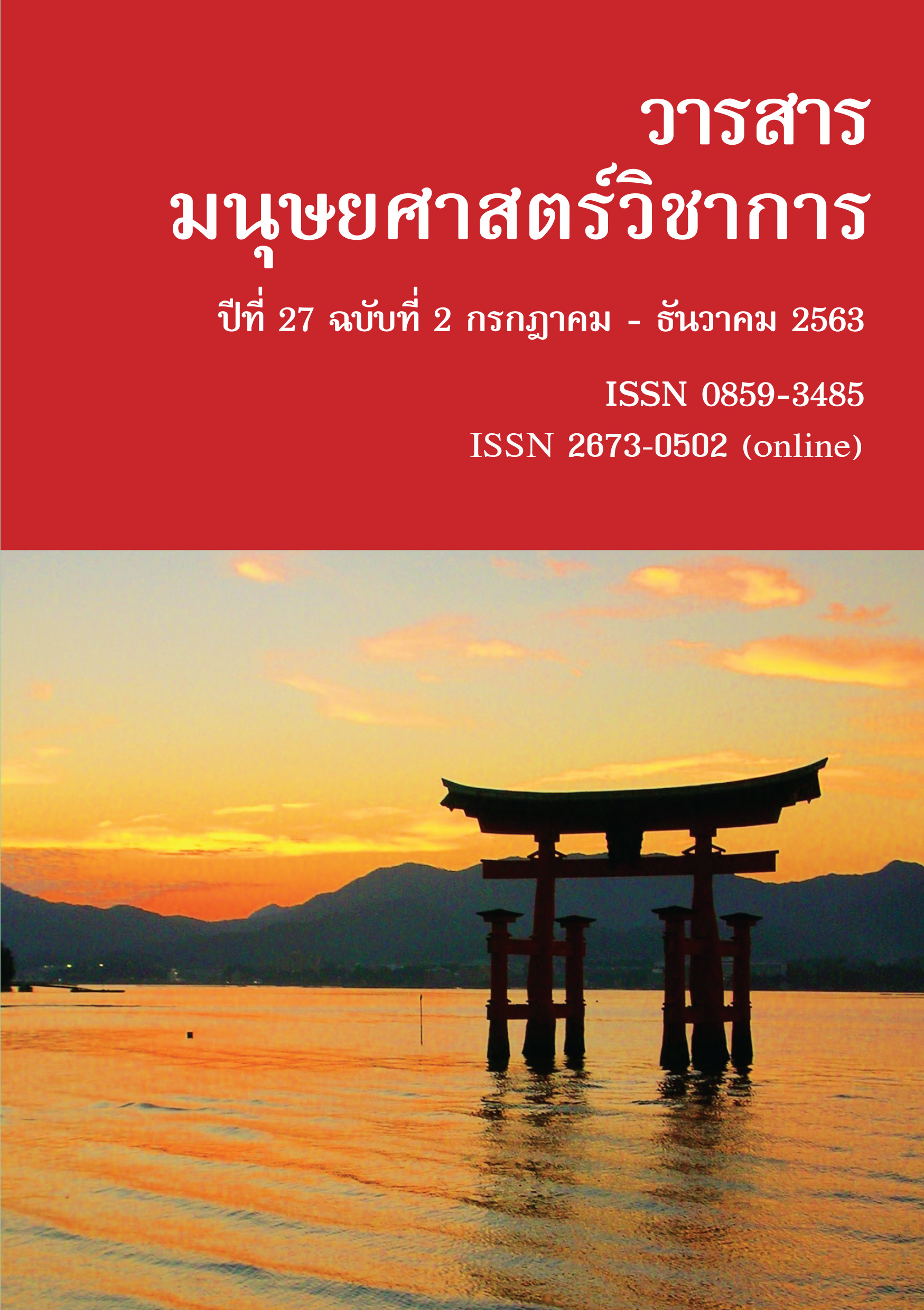อุปลักษณ์มโนทัศน์ “ใจเป็นพื้นที่” ในภาษาไทยเปรียบเทียบกับภาษาจีน
Main Article Content
บทคัดย่อ
บทความวิจัยนี้มีวัตถุประสงค์เพื่อศึกษาอุปลักษณ์มโนทัศน์ “ใจเป็นพื้นที่” ในภาษาไทยเปรียบเทียบกับภาษาจีนตามแนวคิดทฤษฎีภาษาศาสตร์ปริชาน ผลการวิจัยพบว่า อุปลักษณ์มโนทัศน์ “ใจเป็นพื้นที่” ในภาษาไทยและภาษาจีนล้วนสะท้อนให้เห็นถึงระบบมโนทัศน์ของผู้ใช้ภาษาทั้งสองที่มีต่อเรื่อง “ใจ” ซึ่งมีทั้งลักษณะที่เหมือนกันและแตกต่างกัน กล่าวคือ ทั้งในภาษาไทยและภาษาจีนล้วนมีการทำความเข้าใจมโนทัศน์ “ใจ” ในแง่มุมมโนทัศน์พื้นที่ โดยพิจารณากิจกรรมทางความคิด และอารมณ์ความรู้สึกที่แสดงด้วยคำว่า “ใจ” ในทั้งสองภาษานั้นเป็นเหมือนจุดหมายหรือตำแหน่งของพื้นที่ อาจเนื่องจากมโนทัศน์พื้นที่ และความสัมพันธ์ทางพื้นที่มีนัยสำคัญในกระบวนการเรียนรู้ผ่านประสบการณ์ของมนุษย์ที่มีต่อโลก ผู้คนมักจะอาศัยมโนทัศน์พื้นที่ และความสัมพันธ์ทางพื้นที่เป็นรากฐาน โดยใช้ประโยชน์แห่งมโนทัศน์พื้นที่มารับรู้และทำความเข้าใจมโนทัศน์ “ใจ” หรือมโนทัศน์ทางความคิดความรู้สึก ทำให้มโนทัศน์เชิงนามธรรมทางความคิดความรู้สึกสามารถถูกเข้าใจได้อย่างเป็นรูปธรรมมากขึ้น ขณะเดียวกัน ถึงแม้มโนทัศน์ “ใจเป็นพื้นที่” แสดงให้เห็นถึงการรับรู้อันเป็นความเหมือนกันของผู้ใช้ภาษาไทยและภาษาจีนที่มีต่อเรื่อง “ใจ” ว่าเป็นเหมือนพื้นที่ หรือตำแหน่งในพื้นที่ แต่กลับมีความแตกต่างอยู่ในความหมายเปรียบเทียบของ “ใจ” ที่เป็นอุปลักษณ์ในการอ้างถึงความคิดและความรู้สึกออกมาได้แตกต่างกันอย่างมากระหว่างทั้งสองภาษา
Article Details
เอกสารอ้างอิง
คฺยอง อืน ปาร์ค. (2558). มโนทัศน์ของคำว่า ใจ ในภาษาไทยเปรียบเทียบกับภาษาเกาหลี. วารสารศิลปศาสตร์, 15 (กรกฎาคม-ธันวาคม), 199-212.
ราชบัณฑิตยสถาน. (2556). พจนานุกรมฉบับราชบัณฑิตยสถาน พ.ศ. 2554. กรุงเทพฯ : นานมีบุ๊คส์พับลิเคชั่น.
Barsalou, L. W. (1999). Perceptual symbol systems. Behavioral and Brain Sciences, 22, 577-609.
Barsalou, L. W. (2008). Grounded cognition. Annual Review of Psychology, 59, 617-645.
CASS Institute of Linguistics Dictionary (中国社会科学院语言研究所词典编辑室). (2016). The Contemporary of Chinese Dictionary (现代汉语词典 (第 7 版) ). Beijng: The commercial press.
Clark, H. H., & Clark, E. V. (1977). Psychology and Language. An Introduction to psycholinguistics. New York: Harcourt Brace Jovanovich.
Fu, Ning. (2009). A Study on Monosycllabic Localizers in Modern Chinese from the Perspective of Grammaticalization (语法化视角下的现代汉语单音方位词研究). Doctoral dissertation (Linguistics and Applied Linguistics), Shandong University.
Gibbs Jr, R. W. (2006). Embodiment and cognitive science. New York: Cambridge University Press.
Gibson, E. J. (1969). Principles of Perceptual Learning and Development. New York: Appleton-Century Crofts.
Guo, Yu. (2006). A Study of the Combination “Xin+ Location Words’ with Verbs (“心+ 方位词” 与动词组合的研究). Master of Arts (Linguistics and Applied Linguistics), East China Normal University.
Kellman, P. J. (1995). Ontogenesis of Space and Motion Percepti on. In Perception of Space and Motion. In W.Epstein & S. J. Rogers (eds.), Perception of Space and Motion (2nd edition). London: Academic Press,
pp. 327-364.
Lakoff G. (1993). The Contemporary Theory of Metaphor. Metaphor and Thought. ed. by. Andrew Ortony, Cambridge: Cambridge University Press, 202-251.
Lakoff, G. & Johnson, M. (1980). Metaphors We Live By. Chicago, IL: University of Chicago Press.
Lakoff, G. & Johnson, M. (1999). Philosophy in the Flesh . New York: Basic Books.
Lakoff, G. & Johnson, M. (2003). Metaphors We Live By. Chicago: University of Chicago Press.
Lakoff, G., & Turner, M. (1989). More Than Cool Reason: A Field Guide to Poetic Metaphor. Chicago: University of Chicago Press.
Langacker, R. W. (1987). Foundations of cognitive grammar: Theoretical prerequisites (Vol. 1). Stanford university press.
Li, Wenli. (2007). System Research on the Metaphor of Human Body (人体隐喻系统研究). Master of Arts (Linguistics and Applied Linguistics), EastChina Normal University.
Lyons, J. S. (1977). Semantics (Vol. 2). London: Cambridge University Press.
Pérez, R. G. (2008). A Cross-Cultural Analysis of Heart Metaphors. Revista Alicantina de Estudios Ingleses, 21, 25-56.
Schubert T W. (2005). Your highness: Vertical positions as perceptual symbols of power. Journal of Personality and Social Psychology, 2005, 89: 1-21.
Vanparys, J. (1984). Source metaphors in English. Journal of Pragmatics, 8(3), 395-410.
Yu, N. (1998). The contemporary theory of metaphor: A perspective from Chinese (Vol. 1). John Benjamins Publishing.
Zhang, Ruihua. (2008). A Contraste Study of the Metaphor Xin & Heart-Discussing with Wu Enfeng (英汉 “心” 隐喻对比研究-与吴恩锋先生商榷). Journal of Beijing International Studies University, (8), 25-31.
Zhou, Biji. (2006). Multi-angled Study on Noun of Human Organs in Modern Chinese (现代汉语人体名词的多角度研究). Master of Arts (Chinese Linguistics), Central China Normal University.


